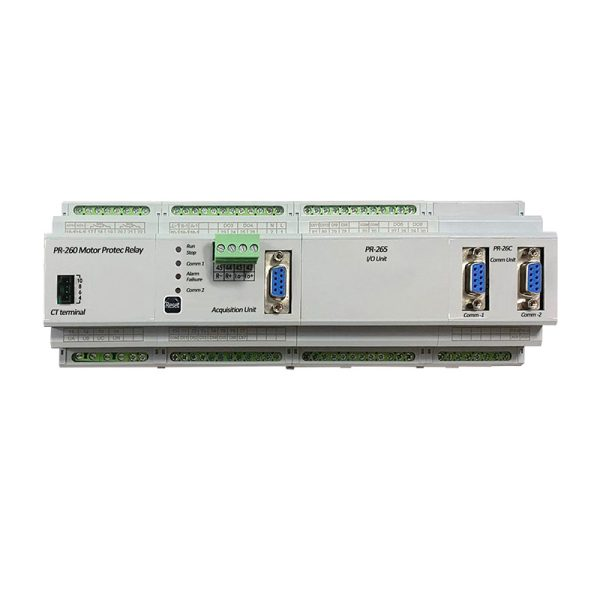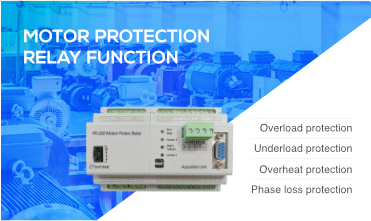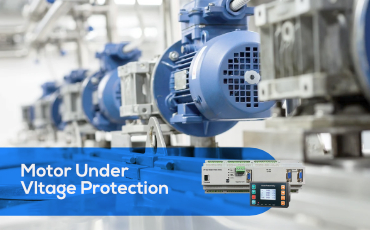
Which relay is used for motor protection
By bluejay | Company News
Want to know which relay is used for motor protection? The type of relay used for motor protection depends on the specific requirements of the motor and the application. This article will introduce some common relays for motor protection.

1. Motor Overload Protection Relay/ Motor Current Protection Relay
A motor overload protection relay, also known as a current protection relay, is a safety device designed to prevent damage to a motor by detecting excessive current draw. When the current flowing through a motor exceeds a predetermined threshold, the relay trips, shutting off the power to the motor. This prevents the motor from overheating and potentially burning out.
Types of Motor Overload Protection Relays
There are several types of motor overload protection relays, each with its unique features:
Thermal Overload Relay: Thermal Overload Relay: This relay, also known as a motor thermal protection relay, uses a bimetallic strip to detect excessive heat generated by the motor. When the temperature of the bimetallic strip reaches a certain point, the relay trips.
Magnetic Overload Relay: This type of relay uses a magnetic coil to detect excessive current. When the current exceeds a predetermined threshold, the magnetic field generated by the coil causes the relay to trip.
Electronic Overload Relay: This type of relay uses electronic circuitry to detect excessive current. Electronic overload relays are often more sensitive and accurate than thermal or magnetic relays.
Key Features of Motor Overload Protection Relays
Adjustable Trip Current: Most motor overload protection relays have an adjustable trip current setting, allowing you to customize the protection for different motors.
Manual Reset: After a trip, the relay can be manually reset to restore power to the motor.
Automatic Reset: Some relays can be configured to automatically reset after a trip, allowing the motor to restart without manual intervention.
Time Delay: Many relays have a time delay feature that prevents the relay from tripping due to momentary current surges.
Remote Monitoring: Some relays can be connected to a control system for remote monitoring and control.
Importance of Motor Overload Protection
Motor overload protection is essential for preventing damage to motors and ensuring the safety of electrical equipment. By using a motor overload protection relay, you can help to:
Prevent motor burnout: Overloading a motor can cause it to overheat and burn out, resulting in costly repairs or replacements.
Protect electrical equipment: Overloaded motors can also damage other electrical equipment in the system.
Improve safety: Motor overload protection can help to prevent electrical fires and other hazards.

2. Motor Voltage Protection Relay
A motor voltage protection relay is a safety device designed to protect a motor from damage caused by abnormal voltage conditions. It monitors the voltage supplied to the motor and trips if the voltage falls outside of a predetermined range. This can prevent the motor from overheating or stalling, which can lead to costly repairs or replacement.
Types of Motor Voltage Protection Relays
There are several types of motor voltage protection relays, each with its own unique features:
Under-voltage relay: This type of relay trips when the voltage supplied to the motor falls below a predetermined threshold.
Over-voltage relay: This type of relay trips when the voltage supplied to the motor exceeds a predetermined threshold.
Under-voltage and over-voltage relay: This type of relay combines the functions of an under-voltage relay and an over-voltage relay.
Voltage imbalance relay: This type of relay trips when there is an imbalance in the voltage supplied to the motor’s three phases.
Key Features of Motor Voltage Protection Relays
Adjustable voltage settings: Most motor voltage protection relays have adjustable voltage settings, allowing you to customize the protection for different motors and applications.
Time delay: Many relays have a time delay feature that prevents the relay from tripping due to momentary voltage fluctuations.
Importance of Motor Voltage Protection
Motor voltage protection is essential for preventing damage to motors and ensuring the safety of electrical equipment. By using a motor voltage protection relay, you can help to:
Prevent motor damage: Abnormal voltage conditions can cause motors to overheat, stall, or burn out.
Improve system reliability: A motor voltage protection relay can help to prevent unexpected system outages.
Reduce maintenance costs: By preventing motor damage, you can reduce the need for costly repairs and replacements.

3. Phase Sequence Relay
A motor phase sequence relay is a protective device used to monitor the phase sequence of the power supply to a motor. The correct phase sequence is essential for the proper operation of a three-phase motor. If the phase sequence is incorrect, the motor may not start, or it may start but run in the wrong direction.
Types of Motor Phase Sequence Relays
There are two main types of motor phase sequence relays:
Electromechanical Phase Sequence Relay: This type of relay uses a mechanical system to detect the phase sequence. It is typically less expensive than electronic relays, but it may be less accurate and reliable.
Electronic Phase Sequence Relay: This type of relay uses electronic circuitry to detect the phase sequence. Electronic relays are generally more accurate and reliable than electromechanical relays.
Key Features of Motor Phase Sequence Relays
Phase Sequence Detection: Motor phase sequence relays can detect both correct and incorrect phase sequences.
Alarm Output: When an incorrect phase sequence is detected, the relay can activate an alarm to alert the operator.
Interlock Function: Some relays can be used to interlock the motor’s starter, preventing the motor from starting if the phase sequence is incorrect.
Importance of Motor Phase Sequence Protection
Motor phase sequence protection is essential for the proper operation of three-phase motors. If the phase sequence is incorrect, the motor may experience the following problems:
Failure to start: The motor may not be able to start at all.
Incorrect direction of rotation: The motor may rotate in the wrong direction.
Overheating: Incorrect phase sequence can cause the motor to overheat and burn out.
Vibration: Incorrect phase sequence can cause the motor to vibrate excessively.
By using a motor phase sequence relay, you can help to prevent these problems and ensure that your motor operates properly.

4. Motor Earth Fault Protection Relay
A motor earth fault protection relay is a safety device designed to protect a motor from damage caused by a ground fault. When a ground fault occurs, the relay trips, shutting off the power to the motor. This prevents the motor from overheating and potentially burning out.
Types of Motor Earth Fault Protection Relays
There are several types of motor earth fault protection relays, including:
Resistance-based relay: This type of relay measures the resistance between the motor’s windings and ground. When the resistance falls below a predetermined threshold, indicating a ground fault, the relay trips.
Current-based relay: This type of relay measures the current flowing to ground. When the current exceeds a predetermined threshold, indicating a ground fault, the relay trips.
Voltage-based relay: This type of relay measures the voltage between the motor’s windings and ground. When the voltage exceeds a predetermined threshold, indicating a ground fault, the relay trips.
Key Features of Motor Earth Fault Protection Relays
Sensitivity: Motor earth fault protection relays are typically very sensitive, allowing them to detect even small ground faults.
Selectivity: Some relays can be configured to be selective, meaning that they will only trip if the ground fault is located within a specific zone.

5. Multifunctional Motor Protective Relay
A multifunctional motor protective relay integrates several protection features into a single unit, simplifying installation and offering comprehensive motor protection. These relays typically include functions of Overcurrent protection, Thermal protection, Phase loss and sequence detection, Voltage protection, and ground fault protection, etc.
Key Features of multifunctional motor protective relay
Communication Capabilities::Many modern multifunctional relays support communication protocols like Modbus, Profibus, or Ethernet for seamless integration with SCADA systems.
Real-time fault notifications help in quick troubleshooting and minimize downtime.
Customizable Settings: Engineers can adjust trip limits and time delays according to specific motor requirements.
Diagnostics and Predictive Maintenance: Some relays provide data logs and alerts for predictive maintenance, reducing the likelihood of unexpected failures.

Conclusion
In addition to the several types of motor protection relays introduced above, there are many other types of relays, such as differential protection relays, overcurrent protection relays, etc., which play different roles in the motor protection system.
Related articles
Tags
Company News
Want to know which relay is used for motor protection? The type of relay used for motor protection depends on the specific requirements of the motor and the application. This article will introduce some common relays for motor protection.

1. Motor Overload Protection Relay/ Motor Current Protection Relay
A motor overload protection relay, also known as a current protection relay, is a safety device designed to prevent damage to a motor by detecting excessive current draw. When the current flowing through a motor exceeds a predetermined threshold, the relay trips, shutting off the power to the motor. This prevents the motor from overheating and potentially burning out.
Types of Motor Overload Protection Relays
There are several types of motor overload protection relays, each with its unique features:
Thermal Overload Relay: Thermal Overload Relay: This relay, also known as a motor thermal protection relay, uses a bimetallic strip to detect excessive heat generated by the motor. When the temperature of the bimetallic strip reaches a certain point, the relay trips.
Magnetic Overload Relay: This type of relay uses a magnetic coil to detect excessive current. When the current exceeds a predetermined threshold, the magnetic field generated by the coil causes the relay to trip.
Electronic Overload Relay: This type of relay uses electronic circuitry to detect excessive current. Electronic overload relays are often more sensitive and accurate than thermal or magnetic relays.
Key Features of Motor Overload Protection Relays
Adjustable Trip Current: Most motor overload protection relays have an adjustable trip current setting, allowing you to customize the protection for different motors.
Manual Reset: After a trip, the relay can be manually reset to restore power to the motor.
Automatic Reset: Some relays can be configured to automatically reset after a trip, allowing the motor to restart without manual intervention.
Time Delay: Many relays have a time delay feature that prevents the relay from tripping due to momentary current surges.
Remote Monitoring: Some relays can be connected to a control system for remote monitoring and control.
Importance of Motor Overload Protection
Motor overload protection is essential for preventing damage to motors and ensuring the safety of electrical equipment. By using a motor overload protection relay, you can help to:
Prevent motor burnout: Overloading a motor can cause it to overheat and burn out, resulting in costly repairs or replacements.
Protect electrical equipment: Overloaded motors can also damage other electrical equipment in the system.
Improve safety: Motor overload protection can help to prevent electrical fires and other hazards.

2. Motor Voltage Protection Relay
A motor voltage protection relay is a safety device designed to protect a motor from damage caused by abnormal voltage conditions. It monitors the voltage supplied to the motor and trips if the voltage falls outside of a predetermined range. This can prevent the motor from overheating or stalling, which can lead to costly repairs or replacement.
Types of Motor Voltage Protection Relays
There are several types of motor voltage protection relays, each with its own unique features:
Under-voltage relay: This type of relay trips when the voltage supplied to the motor falls below a predetermined threshold.
Over-voltage relay: This type of relay trips when the voltage supplied to the motor exceeds a predetermined threshold.
Under-voltage and over-voltage relay: This type of relay combines the functions of an under-voltage relay and an over-voltage relay.
Voltage imbalance relay: This type of relay trips when there is an imbalance in the voltage supplied to the motor’s three phases.
Key Features of Motor Voltage Protection Relays
Adjustable voltage settings: Most motor voltage protection relays have adjustable voltage settings, allowing you to customize the protection for different motors and applications.
Time delay: Many relays have a time delay feature that prevents the relay from tripping due to momentary voltage fluctuations.
Importance of Motor Voltage Protection
Motor voltage protection is essential for preventing damage to motors and ensuring the safety of electrical equipment. By using a motor voltage protection relay, you can help to:
Prevent motor damage: Abnormal voltage conditions can cause motors to overheat, stall, or burn out.
Improve system reliability: A motor voltage protection relay can help to prevent unexpected system outages.
Reduce maintenance costs: By preventing motor damage, you can reduce the need for costly repairs and replacements.

3. Phase Sequence Relay
A motor phase sequence relay is a protective device used to monitor the phase sequence of the power supply to a motor. The correct phase sequence is essential for the proper operation of a three-phase motor. If the phase sequence is incorrect, the motor may not start, or it may start but run in the wrong direction.
Types of Motor Phase Sequence Relays
There are two main types of motor phase sequence relays:
Electromechanical Phase Sequence Relay: This type of relay uses a mechanical system to detect the phase sequence. It is typically less expensive than electronic relays, but it may be less accurate and reliable.
Electronic Phase Sequence Relay: This type of relay uses electronic circuitry to detect the phase sequence. Electronic relays are generally more accurate and reliable than electromechanical relays.
Key Features of Motor Phase Sequence Relays
Phase Sequence Detection: Motor phase sequence relays can detect both correct and incorrect phase sequences.
Alarm Output: When an incorrect phase sequence is detected, the relay can activate an alarm to alert the operator.
Interlock Function: Some relays can be used to interlock the motor’s starter, preventing the motor from starting if the phase sequence is incorrect.
Importance of Motor Phase Sequence Protection
Motor phase sequence protection is essential for the proper operation of three-phase motors. If the phase sequence is incorrect, the motor may experience the following problems:
Failure to start: The motor may not be able to start at all.
Incorrect direction of rotation: The motor may rotate in the wrong direction.
Overheating: Incorrect phase sequence can cause the motor to overheat and burn out.
Vibration: Incorrect phase sequence can cause the motor to vibrate excessively.
By using a motor phase sequence relay, you can help to prevent these problems and ensure that your motor operates properly.

4. Motor Earth Fault Protection Relay
A motor earth fault protection relay is a safety device designed to protect a motor from damage caused by a ground fault. When a ground fault occurs, the relay trips, shutting off the power to the motor. This prevents the motor from overheating and potentially burning out.
Types of Motor Earth Fault Protection Relays
There are several types of motor earth fault protection relays, including:
Resistance-based relay: This type of relay measures the resistance between the motor’s windings and ground. When the resistance falls below a predetermined threshold, indicating a ground fault, the relay trips.
Current-based relay: This type of relay measures the current flowing to ground. When the current exceeds a predetermined threshold, indicating a ground fault, the relay trips.
Voltage-based relay: This type of relay measures the voltage between the motor’s windings and ground. When the voltage exceeds a predetermined threshold, indicating a ground fault, the relay trips.
Key Features of Motor Earth Fault Protection Relays
Sensitivity: Motor earth fault protection relays are typically very sensitive, allowing them to detect even small ground faults.
Selectivity: Some relays can be configured to be selective, meaning that they will only trip if the ground fault is located within a specific zone.

5. Multifunctional Motor Protective Relay
A multifunctional motor protective relay integrates several protection features into a single unit, simplifying installation and offering comprehensive motor protection. These relays typically include functions of Overcurrent protection, Thermal protection, Phase loss and sequence detection, Voltage protection, and ground fault protection, etc.
Key Features of multifunctional motor protective relay
Communication Capabilities::Many modern multifunctional relays support communication protocols like Modbus, Profibus, or Ethernet for seamless integration with SCADA systems.
Real-time fault notifications help in quick troubleshooting and minimize downtime.
Customizable Settings: Engineers can adjust trip limits and time delays according to specific motor requirements.
Diagnostics and Predictive Maintenance: Some relays provide data logs and alerts for predictive maintenance, reducing the likelihood of unexpected failures.

Conclusion
In addition to the several types of motor protection relays introduced above, there are many other types of relays, such as differential protection relays, overcurrent protection relays, etc., which play different roles in the motor protection system.







